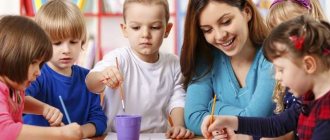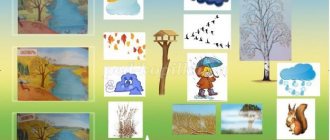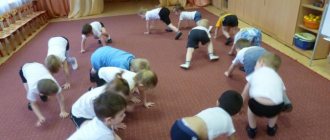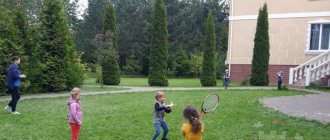Self-analysis of classes at preschool educational institutions
We have offered you a lesson on speech development in the preparatory group on the topic: “Retelling the story by V. Bianchi “Bathing the Bear Cubs.”
I set a goal: developing the skills of a coherent, sequential retelling of text based on graphic diagrams.
The purpose of the lesson is aimed at solving the following problems:
Educational:
- Strengthen children’s ability to listen carefully to a literary text and answer questions about the content.
Educational:
- Develop the ability to explain the meaning of words, come up with graphic diagrams, practice the formation of nouns with diminutive suffixes; develop memory, attention, thinking.
Educational:
- Foster a culture of behavior, friendliness, and respect for each other.
All requirements for conducting the lesson were met.
- Educational activities took place in a clean, ventilated, well-lit room.
- The duration of the lesson corresponds to the norms for children of this age - 30 minutes.
- Children were not allowed to become overtired due to alternating types of activities (conversation, standing on the carpet, game “Name it kindly,” sitting listening to a story, physical education, drawing diagrams, retelling).
The lesson corresponds to:
- General educational and developmental goals and objectives, the level of development of students, their age characteristics.
- Comprehensive thematic planning.
Integration of educational areas in accordance with the age capabilities and characteristics of students in the classroom is implemented through appealing to the experience of children in other educational areas (cognitive development, social and communicative development)
During the lesson, joint activities of adults and children are realized; the main component is interaction.
The goals and objectives of the upcoming activities were revealed to the students quite convincingly, clearly and emotionally.
The work was meaningful, interesting, and organized.
During the lesson, students acquired basic knowledge of breaking a text into parts (this skill was developed by sketching graphic diagrams), the ability to distinguish between singular and plural numbers, and the ability to change words using endings and selecting endings in accordance with gender and number were consolidated. They also showed the ability to control their answers and the answers of other children, and help each other when they have difficulty answering. The children demonstrated concentration of attention when listening to the story and a retelling that was quite close to the text.
During the lesson the following methods and techniques were used:
- focusing and attracting attention;
- activation of speech and cognitive activity;
- activation and independence of thinking;
- development of creative abilities.
- Self-control and mutual control.
To relieve the children's fatigue, physical education was held. Children showed their perception of a work of art using graphic diagrams. Repeated reading and drawing of diagrams allowed children to remember the text and make a retelling using these diagrams, thereby forming coherent speech, visual memory, and thinking. The children tried to retell the text consistently and expressively.
Individual work was manifested in carrying out vocabulary work, helping those who find it difficult to answer, providing reminders, as well as taking into account the peculiarities of thinking and the pace of perception of children.
The characteristics of each child were taken into account (pace of activity, emotional state, level of development, temperament).
I believe that the lesson is structured logically, and the stages are interconnected. During the lesson, I tried to communicate with the children on the same level, tried to maintain the children’s interest in the lesson throughout the entire time. The children were active.
I believe that the goals and objectives set during the lesson were achieved.
Middle group. Junior preschool age. Children 4 - 5 years old
Role-playing game “Let's take dolls for a ride in a car” for children of primary preschool age with self-analysis Goal: development of the ability to transfer familiar actions with building material to new play situations. Objectives: -Develop the ability to play with peers. - with the help of an adult, perform several game actions united by a plot outline. -promote the desires of children...
Self-analysis of the developing subject-spatial environment of the middle group
When building a subject-developmental environment in our group, we remembered “On the approval of the federal state educational standard for preschool education.” According to clause 3.3.4. According to the standard, the subject-spatial environment of the group should be content-rich,...
Self-analysis - Self-analysis for the abstract of the GCD for FEMP “Transport” (middle group)
Publication “Self-analysis for the summary of the educational activity on FEMP “Transport” (secondary..." Self-analysis of direct educational activities on cognitive development (FEMP) using modern educational technologies "Logical blocks of Dyenesh" Alexandra Gabdullaevna Reichert This open lesson was conducted with a subgroup of children of the middle group...
Self-analysis of the lesson in the middle group “Amazing Salt” Self-analysis of the NOD Direct educational activities were carried out at Sukhobuzimsky d/s No. 4 on March 4, 2022. with children of the middle group in the amount of 12 people. Educational activities were carried out in the field of knowledge, educational and research activities on the topic...
Self-analysis of educational activities for speech development in the middle group on the topic “Wild Animals” Self-analysis of educational activities for speech development in the middle group on the topic: “Wild Animals.” We have presented to your attention an integrated direct educational activity for children of the middle group on the topic “Wild Animals”. Objectives: “Speech development” • Use in practice…
Self-analysis of the final lesson on music education in the middle group “Merry Spring” Your attention was given to the final lesson in the middle group on music education. Theme: “Happy Spring.” Goal: to consolidate and generalize in children the knowledge, skills and abilities previously acquired in music education classes. Objectives: educational: • consolidate knowledge…
Self-analysis of an open lesson on the Federal State Educational Standard 2016
GCD Self-Analysis
Topic: “A fairy tale comes to visit us” in the senior group of kindergarten No. 1 “Topolyok”, teacher Akinina N.A.
During the lesson “A fairy tale comes to visit us” the following goal was set:
-Develop the ability to recognize individual fairy tales by their characteristic features and be able to play them out, activate speech, enrich vocabulary, learn to select words and antonyms that define the characters; maintain interest in fairy tales, promote the development of moral qualities in children, evoke sympathy, empathy, and a desire to help.
Integration of educational areas: “Communication”, “Cognition”, “Physical Education”, “Music”.
Preliminary work: reading fairy tales about animals, fairy tales, social fairy tales, looking at illustrations for fairy tales, talking about fairy tales, reading proverbs, dramatization games based on fairy tales.
GCD structure
Direct educational activities (hereinafter referred to as GED)
It was carried out with a group of children of senior preschool age 5 - 6 years old.
The educational activity itself consisted of three interconnected parts, during which children gradually performed various actions. This structure is completely justified, since each part of direct educational activity is aimed at solving certain problems and offers a choice of methods and techniques
Introductory part
organization of children, motivation for upcoming activities. At the organizational stage of the NOD, the problem-situational method was used. The children were invited to go to a fairyland.
Main part
ECD was a specially organized and independent activity of children aimed at solving assigned tasks.
Throughout the entire process, the NOD created problematic situations, rescuing the heroes of fairy tales from the Serpent Gorynych.
In the final part
GCD also used a game problem situation - returning to the group with the help of counting on an airplane carpet, there were surprise moments, these were characters from fairy tales - Baba Yaga and Cinderella, memorable souvenirs (books). She reinforced the positive results of the session with verbal encouragement.
To implement each task, I selected techniques that helped solve them. The techniques were based on play situations in which I tried to consolidate children's knowledge about fairy tales.
When working with children, I used conversation, questions to children for intelligence and logical thinking - all this contributed to the effectiveness of educational activities, mental activity and cognitive development of children.
The material for the educational activities was selected at a level accessible to children, corresponded to their psychological characteristics and was rational for solving the set goals and objectives. They were active, attentive, and felt comfortable. All this is confirmed by the results of our activities.
All elements of GCD are logically united by a common theme.
This structure of the lesson is completely justified. Since each part of the lesson is aimed at solving certain pedagogical problems and offers a choice of adequate methods and techniques. The content of the lesson corresponded to the assigned tasks.
Activities at GCD are characterized as joint and individual.
At GCD I used the following forms of work: frontal, individual, group.
Methods:
1. Verbal (questions for children, clarification, encouragement, selection of antonyms);
2. Visual demonstration (depiction of fairy tale characters, objects with which they are associated);
3. Practical (finger gymnastics “Favorite Fairy Tales”, puzzles of fairy tale heroes, physical education on a fairy tale, laying out grains, psycho-gymnastics “Kolobok”)
4. Game (travel to a fairyland, helping the heroes of fairy tales)
5. Methods of control (analysis of completed tasks, evaluation of performance results using souvenirs (books));
Methods include a system of techniques that are combined to solve learning problems. Techniques (explanations, instructions, demonstration, commands, play techniques, artistic expression, encouragement, helping the child, analysis, introductory conversation) are aimed at optimizing the individual development of each child.
I believe that the form of organizing the direct educational activities of children that I chose was quite effective and dynamic. I tried to comply with the norms of pedagogical ethics and tact. I believe that the tasks set in direct educational activities were completed! GCD has achieved its goal!
Self-analysis and technological map of the lesson “Some properties of air”
- June 29, 2020
International and All-Russian competitions
All-Russian competition of pedagogical excellence “Methodological piggy bank of a kindergarten teacher”
The lesson was conducted by Khrykina O.A., teacher of the MDOU Kindergarten “Golden Key” in Zheleznogorsk-Ilimsky, Irkutsk region.
In the system of specially organized educational activities within the framework of the thematic block “The Air Around Us”, this lesson is the first introductory lesson.
The purpose and objectives of the lesson are interconnected and appropriate to the age of the children.
The content of educational activities is clearly structured into three main stages: organizational-motivational, informational-practical and reflective-evaluative.
At the first organizational and motivational stage, I created a motivational situation corresponding to the age category of children, using the game characters Shar Sharycha (balloon) and Kam Kamycha (stone). The children were asked to help find out the reason for Shar Sharych's failure in the competition with Kam Kamych.
She relied on the children’s personal motives with the question “Who wants to help?” The game experiment “One, two, three – touch the ground” allowed children to be motivated to be productive
In the main, informational and practical part of the lesson I used the following methods and techniques:
- visual (use of map diagrams of the rules for conducting experiments, use of multimedia in the game “Who Needs Air?”);
- practical (experiments and experiments to identify certain properties of air, articulatory gymnastics);
- verbal (questions of a searching and leading nature);
- gaming (game characters, game "Air Catchers")
To reinforce ideas about air and the need for air for all living things, I used a productive method - drawing on balloons.
At this stage, I created choice situations : choosing a place to catch air, choosing a picture on a ball.
The tasks for children have a sufficient level of difficulty and correspond to the age category.
During the lesson I used the following ways to organize children:
- in subgroups (in the game “Air Catchers”);
- in pairs (experimental game “One, two, three - touch the ground!”)
- individually (experience “Air is lighter than stone”, drawing on balls);
- frontally (conversation with characters, drawing conclusions, final discussion of experimental results).
I followed the methodology for guiding children’s experimental activities
The final part of the lesson was aimed at developing children's reflective assessment skills, which corresponded to the age characteristics of the children and was interconnected with the purpose of the lesson.
I discussed with the children the prospect of using images on balloons (use them in the “Save the Air!” campaign, distribute them to adults on the street or to parents of older children). The reflective component is interconnected with the motivational one: they wanted to help Shar Sharych - they helped.
During the lesson I implemented the basic didactic principles:
- availability of material sold, taking into account age characteristics;
- visibility when performing tasks.
The activity-based and personality-oriented approaches were clearly expressed (situation of choice, creation of a situation of success, different forms of organizing children, reflexive component). A sufficient degree of motor activity of the children was observed (various forms of organizing tasks). I noted a high degree of cognitive and speech activity in children.
Thus, the use of the above methods, techniques, ways of organizing children, principles and approaches in the lesson made it possible to realize the assigned tasks and purpose of the lesson in full and achieve the planned results.



